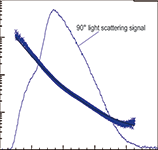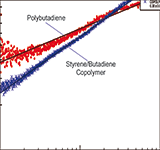Synthetic Rubbers: Polybutadiene
Synthetic elastomers have replaced natural rubber to an astonishing degree, and account for more than 70% of the rubber used today.
Synthetic elastomers have replaced natural rubber to an astonishing degree, and account for more than 70% of the rubber used today. In the United States alone, 5 million tons of synthetic rubber are produced annually. The principal synthetic rubber elastomer is a copolymer of butadiene and styrene. The latex form of rubber and synthetic elastomers has applications in carpet and gloves, and coagulated latex is used for the production of tires and mechanical goods. It is of critical importance to know the absolute molar mass and its distribution, as well as to gain insight into the conformation of synthetic rubber — which are indicative of the product's end-use performance.
Typically, polystyrene standards are used to estimate the molar masses of these polymers in SEC experiments, but by using a DAWN or miniDAWN multi-angle light scattering (MALS) detector, standards and column calibration are no longer needed. Here, the absolute molar mass and polydispersity, as well as the rms radius of two synthetic rubber samples were measured directly using SEC combined with a DAWN.
The synthetic rubber samples were analyzed in toluene, and Wyatt Technology's Optilab was used as the refractive index detector for the SEC line. The refractive index increment dn/dc of polybutadiene in toluene is relatively low, and the dn/dc value of the butadiene/styrene copolymer in toluene increases with the ratio of styrene present. In Figure 1, the molar mass and its distribution are determined absolutely — without using any standards or calibration routines.

Figure 1: Molar mass versus elution time for the synthetic rubber sample superimposed upon the signal from one of the light scattering detector channels.
In addition to the weight-average molar mass and the polydispersity, the DAWN can also determine the shape of the polymer by measuring the rms radius directly at each elution volume. It is well-known that butadiene forms highly branched polymers and that styrene forms linear polymers — and this is revealed by the DAWN.

Figure 2: RMS radius versus molar mass ("conformation plot") for the two samples. The slope is indicative of the conformation (rod, coil, or sphere) of the molecule.
Figure 2 shows a logarithmic plot of the molar mass versus the radius of the two synthetic rubber samples. The slope of such a plot is indicative of the shape of a polymer. A slope between 0.5 and 0.6 is usually found for linear polymers with a random coil conformation, while spheres have a slope of approximately 0.3. The values obtained for polybutadiene (0.25) and for the butadiene/styrene copolymer (0.38) indicate that this polybutadiene is more branched than the styrene/butadiene copolymer.
DAWN®, ASTRA®, AURORA®, and the Wyatt Technology logo are registered trademarks of Wyatt Technology Corporation. © 2014 Wyatt Technology Corporation 4/14/2014

Wyatt Technology
6300 Hollister Avenue, Santa Barbara, CA 93117
tel. +1 (805) 681-9009, fax +1 (805) 0123
Website: www.wyatt.com

SEC-MALS of Antibody Therapeutics—A Robust Method for In-Depth Sample Characterization
June 1st 2022Monoclonal antibodies (mAbs) are effective therapeutics for cancers, auto-immune diseases, viral infections, and other diseases. Recent developments in antibody therapeutics aim to add more specific binding regions (bi- and multi-specificity) to increase their effectiveness and/or to downsize the molecule to the specific binding regions (for example, scFv or Fab fragment) to achieve better penetration of the tissue. As the molecule gets more complex, the possible high and low molecular weight (H/LMW) impurities become more complex, too. In order to accurately analyze the various species, more advanced detection than ultraviolet (UV) is required to characterize a mAb sample.















